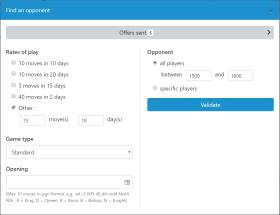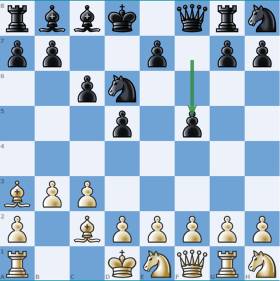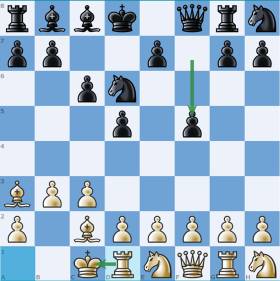"Longterm Play" is the modern version of "Correspondence chess play". Instead of sending postal mail, now it's easier to play directly on the Internet using a gaming interface, while maintaining a pace that allows you to take time to think. According to the rate of play of your choice, the games are spread over several days or weeks. Several games can be played simultaneously and it is also possible to enter in to tournaments.
Frequently asked questions
Longterm play Q&A
The principle of the longterm play is to have more time to think. Thus, the use of an analysis module (Stockfish, Komodo, Fritz, etc.) removes much of the interest in this practice. Worse, if a player is "assisted" by an analysis module while his opponent does not use it, it is simply cheating.
However, if several players wish to compete "assisted" by an analysis module, we suggest that they create a sub-account reserved for this purpose by ticking the box: "I am using an analysis program to play with this username." By doing so, an icon will appear next to your username to indicate that you are playing "assisted" by a module.
To start a game two options are available. Games can be accessed via the two buttons of the interface shown below:
1) Find an opponent
This feature allows you to send game proposals to other players.
You propose one or more game speeds that suit you, the type of game, the range of the Elo rating of your opponents, and you can even propose a particular "Opening" by entering the first moves.
Fill in the form and validate. Here are some details on the proposed fields:
- Game speeds: if you select several speeds, several game proposals will be sent (1 per selected rate).
- Game type: you can play "classic" chess (Standard) or Fischer Random.
- Opening: you can start the game with a series of forced moves (in pgn format), which allows you to make use of a precise opening
- Opponent:
- “all players”: send the proposal to all players matching the specified Elo rating.
- "specific players” : send the proposal only to the players whom you have selected.
When a player accepts one of your proposals, you are notified by email.
This page also gives you access to your proposals sent. You can cancel them at any time.
2) Offers received
This feature allows you to view the proposals received from other players and to accept or decline them. Upon acceptance, the game begins.
A speed of 10 moves in 10 days (abbreviated as10 mvs/10 d) means that players must make at least 10 moves in 10 days to then again enjoy 10 days to play the next 10 moves. And so on... Unused days do not add up.
To castle, move your King two squares to the right for short castling, or two squares to the left for long castling. Casting is only permitted under the following conditions:
- all the squares between the King and the Rook must be empty
- neither the King nor the Rook must have previously moved from their initial square
- the King must not be in check at the time of castling or afterwards
- the King must not "pass over under a check" by performing the castling
In Fischer Random mode, castling is done by keeping "the King on the Rook" with which he wishes to castle.
Even if at the beginning of each Fischer Random game the pawns of each player are placed exactly as in the beginning of a classic Chess game, the position of the pieces is randomly drawn by computer. However, one Rook will always be to the left of the King and the other to its right. One Bishop will always be on white squares and the other on black. In the starting position, whites and blacks clearly have an identical and symmetrical position.
In Fischer Random, there are 960 possible starting positions: the starting position of standard Chess game and 959 other positions. Of course, in Fischer Random, the castling rule is modified to allow the possibility of making short and long castling from any of the 960 initial positions.
All rules, except for castling, are identical to those of standard Chess.
Castling in Fischer Random
To perform the castling, simply place "the King on the Rook" that needs to be castled. See below for an example of the long castling by the Whites.
As in classic chess:
- all the squares between the King and the Rook must be empty
- neither the King nor the Rook must have previously moved from their initial square
- the King must not be in check at the time of castling or afterwards
- the King must not "pass over under a check" by performing the castling
The positions of the King and the Rook after castling are exactly the same as those of classic chess castling.
In the menu at the top of each longterm play page, click on "Holidays".
Then click on "Add" to set the period of absence. Choose your period of absence from the calendar (click on the start date, then click on the end date to set the date range).
Your games will be paused during this period, and then the countdown will resume the following day. It is possible to cancel a period of absence, but only before it starts.
In the drop-down menu at the top of each longterm play page, click on "Tournaments". Please note that this feature is only available to subscribers.
Please note that direct access is also available from the game page:
This will then take you to the page that is shown below, which lists the tournaments you can take part in.
Participate in a tournament
Simply click on the "Enter" button that is available in front of each tournament. Once the required number of players has been reached, you will be notified via email that the tournament has started. You can then participate in several tournaments at the same time.
Create a tournament
If no tournament meets your expectations, the easiest way is to create one with the criteria of your choice: invited players (all players, or players that you select), the number of players, the Elo range, the game speed and the type of tournament: "one way" or "round trip".
You can also organize a "thematic" tournament, by entering an opening, so that all games of this tournament start with this opening. The entry of the opening must be in PGN format (a standard) and therefore with the initials of pieces in English. Example of a Spanish opening: 1. e4 e5 2. Nf3 Nc6 3. Bb5, etc.
Once the required number of players has been reached, you will be notified via email that the tournament has started.
During a game, it is possible to insert a comment for each move played.
These comments are displayed next to the corresponding moves. They are stored in the game, and restored in the PGN file.
It is possible to contact a player by email at any time.
- Click on the player's username to access their profile:
- Click on the "Contact" button:
Please note that this button is only available if the player has activated the possibility of being contacted.
- Enter your message and then send.
Once the contact is established, you may, if you wish, continue communicating only via email without going through the site.
The Elo rating, named after its inventor Arpad Elo, a Hungarian mathematician, calculates the level of players between them. This rating is based on the probability of winning between the players.
On the site, each player sees their Elo rating automatically updated at the end of each game. Even if the rating of the site does not have the same official status as the rating of the World Chess Federation (FIDE) because of various conditions (at home, in front of a screen, 2D, quiet, no opponent in front, etc.), it anyway allows one to determine the level of the opponents.
Estimation of levels:
- 1000-1300 = beginner
- 1400-1700 = club player and occasional competition player
- 1800-2000 = regular competition player
- 2100-2300 = strong amateur player
- 2400 = International Master
- 2500 = International Grandmaster
- 2600 = World's Top 100
- 2700 = World's Top 50
- 2800 = World champion
It may be interesting to know a little more about one’s opponents, and more generally the other players of the site. Do not hesitate to fill out your information page. Some information like: How long have you been playing chess? Have you ever played in a club? If yes, which? In which city do you live? What are your favorite game speeds? etc., can be useful.
From the site, click on your username at the top right, then on "My account" and then on "My profile". In the same manner, it is always nice to see an “avatar” rather than having nothing in that space.




















